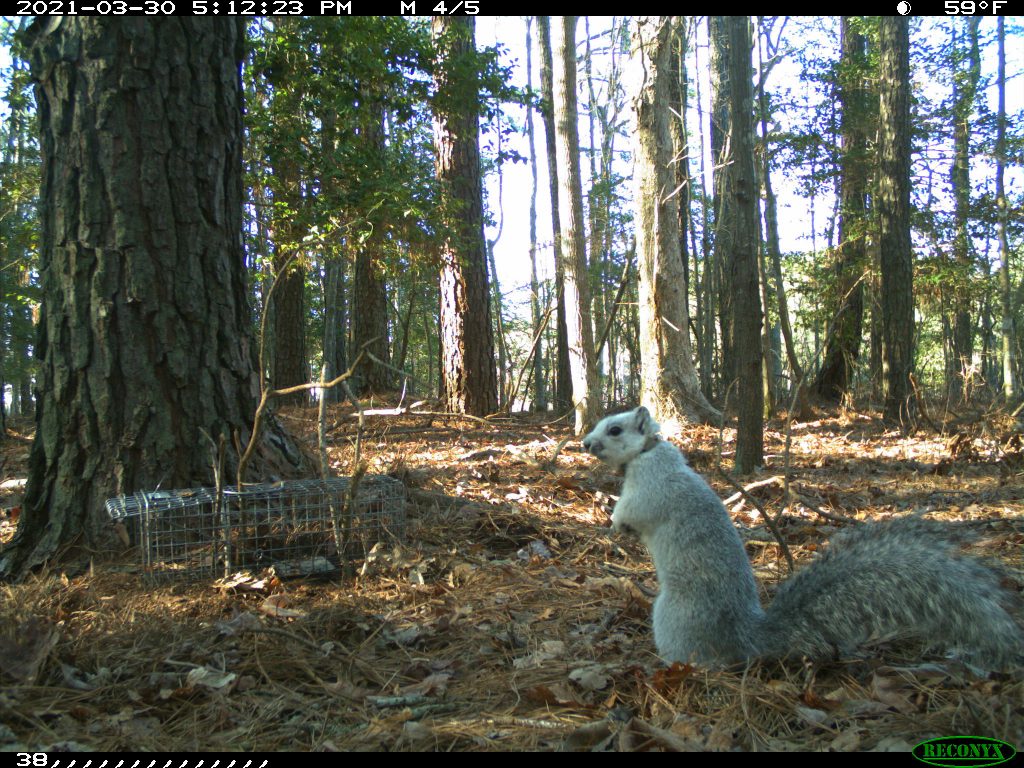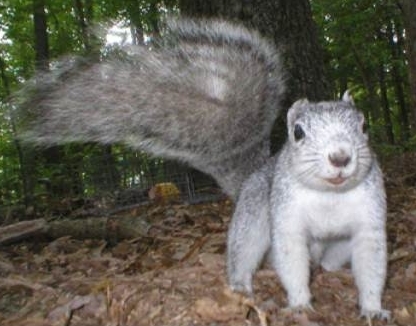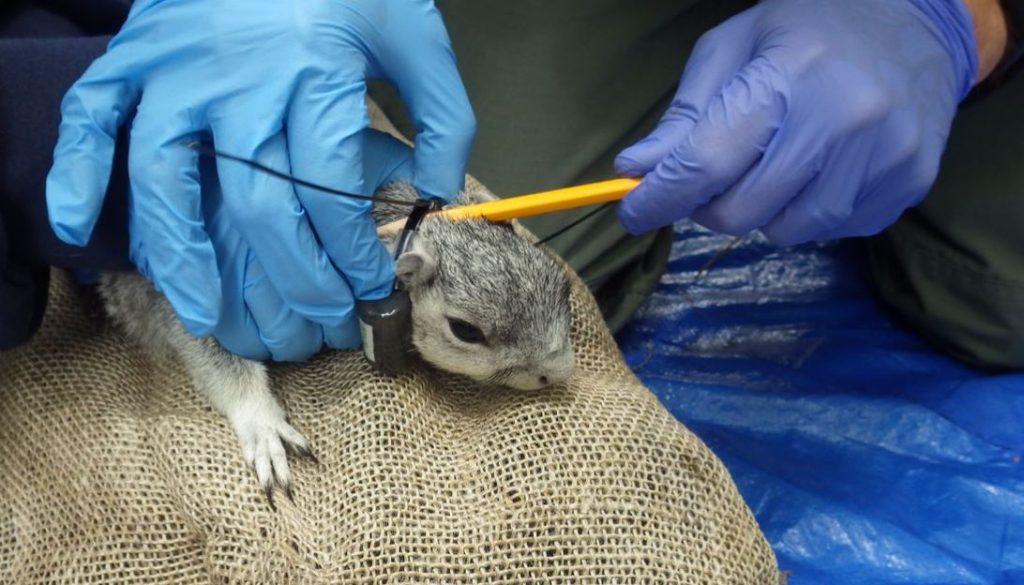Outdoor Delaware is the award-winning online magazine of the Delaware Department of Natural Resources and Environmental Control. Articles and multimedia content are produced by the DNREC Office of Communications.
You probably don’t think of squirrels as rare — after all, you see them all over the place. Darting back and forth across the road, nabbing acorns, stealing birdseed and jumping from tree to tree, the critters are omnipresent.
But for all those squirrels and their antics, you have probably never seen a Delmarva fox squirrel in Delaware. This subspecies is rare, only occurring on the Delmarva Peninsula, including just a few places in Sussex County.

Delmarva fox squirrels have silver-gray coats, small ears and tails that are longer and fluffier than the more common eastern gray squirrel. They can weigh up to 3 pounds and grow up to 30 inches long including a bushy tail, which can reach 15 inches. The gray squirrel, in contrast, is roughly 18 inches long and weighs about a pound.
Delmarva fox squirrels are one of the 10 recognized subspecies of fox squirrels, the largest tree squirrels in North America.
But just because you haven’t seen one yet doesn’t mean you won’t in the future, especially if you live in southern Delaware: The Delaware Department of Natural Resources and Environmental Control and its partners have brought more Delmarva fox squirrels into the state.
Report your sightings. And get answers to frequently asked questions or call 302-735-3600.
From 2020 to 2024, DNREC translocated 123 Delmarva fox squirrels to Sussex in 12 separate batches: 41 at Assawoman Wildlife Area, 48 at Redden State Forest and 34 at Trap Pond State Park. A near-even mix of males and females were translocated to facilitate breeding and hopefully spark a noticeable increase in the population over the years to come.
All the squirrels came from robust populations on private and public lands in Dorchester County, Maryland. Great care was taken to make their transition to the First State as smooth as possible, according to Holly Niederriter, a recently retired wildlife biologist with the DNREC Division of Fish and Wildlife who worked on the project for years.
The charismatic Delmarva fox squirrel’s population numbers started to decline in the early 20th century when nearly all the old-growth forests the species relied on for habitat were cut down to provide timber for construction. The Delmarva fox squirrel was one of dozens of critters on the first federal list of endangered species in 1967, but strong efforts by many entities, from government agencies to conservation-minded nonprofits, have helped regional populations recover.

As a result, the Delmarva fox squirrel was removed from the federal endangered species list in 2015, one year after DNREC developed a conservation plan to increase the number of Delmarva fox squirrels in Delaware. Translocations are the backbone of the Delmarva Fox Squirrel Conservation Plan, but habitat management also plays a role.
Delmarva fox squirrels are now abundant on Maryland’s Eastern Shore. But they remain rare in Delaware, with only two known populations before the translocations. Unlike its relatives, the Delmarva fox squirrel is very slow to expand its range and colonize new territories.
The species prefers old forests with tall trees, which made it difficult to find suitable locations for translocation, though DNREC biologists ultimately did select three such places in Sussex they felt confident the squirrels could thrive in.
The Delmarva fox squirrels captured for translocation were fitted with radio collars attached with special zip ties designed to lie flat when fastened. A pencil was used as a spacer to make sure the zip tie was not too tight around the squirrel’s neck.
DNREC manually tracks the squirrels with specialized receivers. Once squirrels are detected, DNREC scientists enter the data from their phones using a program called Survey123, which automatically saves it into spreadsheet and GIS formats. That helps the agency monitor their movements using a sophisticated mapping system.
So far, so good. The early returns from this project have been very successful, with documented reproduction at all three sites.

As is fairly common, some of the new recruits managed to get out of the collars put on them to study their movements. Some of the collars broke, and some slipped over the squirrels’ heads. Other squirrels were eaten by predators like hawks or foxes, as the species is larger and slower than the gray squirrel.
The observed mortality rate is around 35%, which may seem high but is actually quite typical.
Going into this initiative, DNREC judged it would be a success if it was able to, by 2023, capture at least one female showing signs of having young and at least one other new (non-translocated) adult in the area or two or more juveniles and at least one other adult.
Niederriter was pleased to say her team observed young squirrels and even captured some unmarked juveniles. Though it’s impossible to say exactly how many have mated, they have confirmed at least a few squirrels have reproduced at all the sites they were transported to. Reproduction is documented either by capturing lactating (milk-producing) females or young.
DNREC has been able to track several squirrels as they have moved from their new homes. While one went from Trap Pond all the way back to Maryland, another traveled from Redden State Forest to Pemberton Forest Preserve a few miles north. It’s been extremely gratifying for the dedicated scientists working on this initiative to see the species spread out and to receive proof of reproduction, Niederriter said.
The Department has captured some squirrels without collars on camera, so its wildlife experts know some of those who slipped or broke their collars are alive and well.
Long-term success will be measured in the next decade or so if Delmarva fox squirrels are documented continuing to breed and the survival of new unmarked adults can be confirmed. DNREC will study that with a combination of trapping and photo monitoring.
DNREC will continue tracking the species in the coming years, with photo monitoring playing a major role here. The Department recently received a five-year grant that will help fund efforts in this important area.

The agency plans to set up 40-acre grids near each of the release sites to determine how much habitat is occupied. If the acreage of occupied habitats increases, that’s an excellent sign. If it declines, it may need to do some research to determine the reason. This could include habitat examination or trapping to allow us to study squirrels.
Right now, though, there are no plans to introduce more Delmarva fox squirrels to the First State.
Since they are no longer a federally listed endangered species, landowners should not be concerned if they see unusual-looking squirrels on their property.
Hunting of Delmarva fox squirrels is prohibited, so it is important hunters note the differences between them and the more commonly seen eastern gray squirrels. DNREC plans to do outreach to hunters to ensure they don’t unknowingly harvest these rare mammals.
The hope is the Delmarva fox squirrel will wind up a success story like the wild turkey, which went extinct here in the late 1800s, was reintroduced about a century later and now has a healthy population in our state.
Editor’s note: This article was published in 2021 and updated in 2025.
Related Topics: animals, conservation, delmarva fox squirrel, education, nature, science, squirrels, wildlife